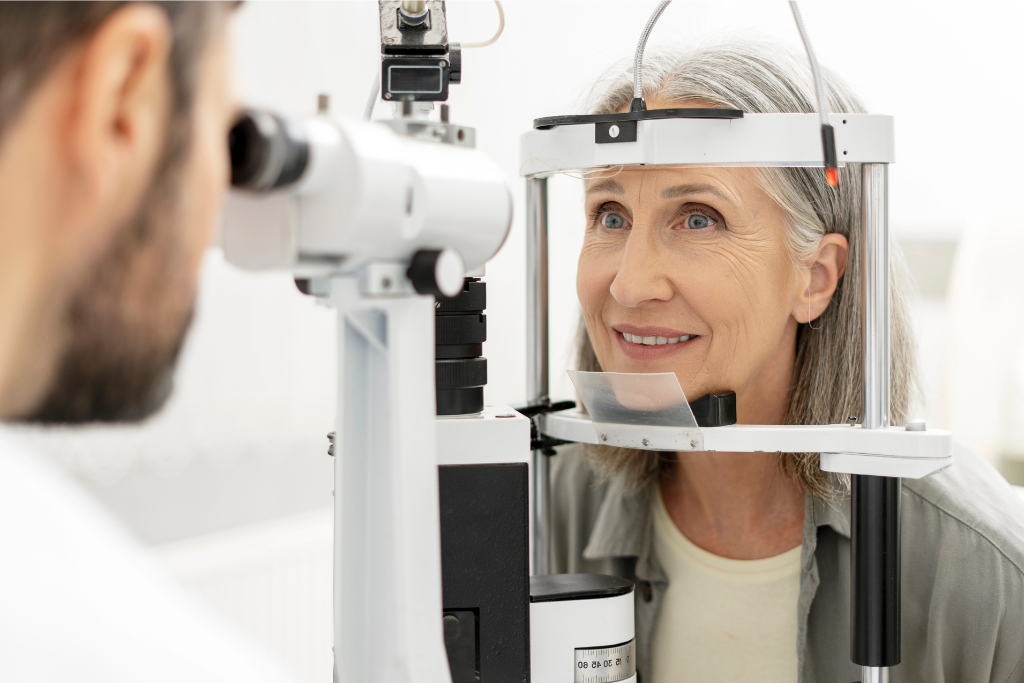Are you noticing a subtle, fleshy growth on the white of your eye? Do you often experience redness, irritation, or a gritty feeling, especially after a long day outside? You might be dealing with a pterygium, commonly known as “surfer’s eye.” This benign, wedge shaped growth is more than just a cosmetic concern; it’s a direct indicator of prolonged environmental exposure, particularly to the sun’s harsh ultraviolet (UV) rays. While it’s prevalent among surfers and sailors, anyone who spends significant time outdoors in sunny climates, like those of us enjoying the perpetual sunshine of Southern California, is at risk.
The good news is that you have the power to protect your eye health. We’ll look at what a pterygium is and, more importantly, highlight practical, natural ways to protect eyes from UV to help you prevent this condition from taking hold. By making a few simple, everyday changes, you can enjoy the beautiful outdoors without compromising your vision.
What Is a Pterygium?
A pterygium is a non cancerous growth of the conjunctiva, the transparent membrane that covers the white part of your eye. It typically starts on the inner corner of the eye, near the nose, and slowly grows towards the pupil. While it can remain small and asymptomatic, it can also cause significant issues. Common symptoms include persistent redness, a feeling that something is in your eye, burning, itching, or in advanced cases, blurred vision if the growth encroaches on the cornea.
The primary risk factor for developing a pterygium is chronic exposure to UV radiation. Dusty, windy, and dry environments can also exacerbate the condition. If you live in a perpetually sunny region or have an outdoor occupation, understanding how to prevent pterygium becomes a critical part of your overall health strategy. The connection between UV rays and pterygium is so strong that doctors often describe it as a “sun induced” condition, making UV protection your first and most effective line of defense. So, do UV rays cause pterygium? The answer is a resounding yes.
Also Read: When a Red Eye Isn’t Just Dryness: Spotting a Pterygium Early
The Role of UV Light in Eye Damage
Just as UV rays can cause sunburn and increase the risk of skin cancer, they are also a leading cause of damage to the delicate tissues of the eye. Long term exposure to these harmful rays can lead to cellular and tissue changes on the surface of the eye. This chronic damage not only raises the risk of a pterygium but is also a major contributor to other serious eye conditions, including cataracts and age related macular degeneration (AMD).
Think of eye protection as being just as important as sunscreen. While many of us remember to slather on SPF before a day at the beach, we often forget that our eyes are absorbing the same damaging radiation. Protecting your eyes from this invisible threat is a key component of long term eye health tips. By understanding the risks, you can take proactive steps to safeguard your vision for years to come.
Natural Prevention Strategies
When it comes to preventing pterygium naturally, the focus is on a holistic strategy that combines protective habits and nutritional support. Here are some of the most effective methods:
- Sunglasses with 100% UV Protection: This is the most critical step you can take. Your sunglasses should be labeled to block 99% or 100% of both UVA and UVB rays. Wraparound frames offer the best protection by blocking light from the sides, ensuring your eyes are shielded from all angles. For anyone living in a sun drenched city, searching for “pterygium Los Angeles” and similar terms often leads to advice on the necessity of high quality sunglasses.
- Wide Brimmed Hats: A wide brimmed hat provides an additional layer of defense. It significantly reduces the amount of direct sunlight hitting your face and eyes, providing shade and minimizing your overall exposure.
- Artificial Tears/Lubricating Drops: Dryness can aggravate a pterygium and its symptoms. Using preservative free lubricating eye drops can help keep your eyes moist and comfortable, preventing the irritation that can worsen the condition.
- Avoid Peak UV Hours: The sun’s UV rays are strongest between 10 a.m. and 4 p.m. Limiting your time outdoors during these hours or seeking shade can drastically reduce your exposure.
- Healthy Diet: A diet rich in antioxidants and healthy fats is vital for eye health. Incorporate foods high in omega 3 fatty acids (salmon, walnuts), Vitamin C (citrus fruits), Vitamin E (nuts, seeds), and the powerful antioxidants lutein and zeaxanthin (found in leafy greens like spinach and kale). These nutrients help protect the eye from oxidative stress and inflammation, complementing your external protection measures.
These tips to avoid pterygium in Southern California sun are not just for surfers; they are essential for anyone who enjoys an active outdoor lifestyle.
Also Read: Can You Wear Contacts With a Pterygium?
Lifestyle Adjustments for At Risk Patients
For those with a high risk lifestyle, like outdoor workers, athletes, or anyone with a family history of the condition, a few extra precautions can make a big difference. Always wear protective eyewear, such as sunglasses or goggles, that are designed to shield your eyes from UV rays, dust, wind, and other irritants. In addition, avoiding smoking is a key lifestyle adjustment, as it can increase eye dryness and contribute to irritation. Finally, regular check ups with an ophthalmologist are important for early detection and management.
When to See an Eye Doctor
While preventing pterygium naturally is the goal, it’s important to know when to seek professional help. If you notice any of the following, it’s time to schedule an appointment with an eye care specialist:
- Persistent eye redness, irritation, or a foreign body sensation.
- A noticeable growth on the white of your eye that seems to be getting bigger.
- Changes in your vision, such as blurriness.
A local search for an “eye doctor near me” can connect you with the expertise you need. While a small pterygium may be managed with lubricating drops and sun protection, larger growths may require steroid drops to reduce inflammation or, in some cases, surgical removal. Early consultation can prevent the need for more invasive treatments.
Also Read: Pterygium Removal: When Surgery Becomes Necessary
Conclusion
Protecting your eyes from the sun is a lifelong habit that pays immeasurable dividends. A pterygium is a clear warning sign of chronic UV exposure, but it’s not an inevitable part of living in a sunny climate. By adopting simple, daily habits, like wearing 100% UV blocking sunglasses, donning a wide brimmed hat, and nourishing your body with a healthy diet, you can significantly reduce your risk of developing this condition and other serious eye diseases.
Your vision is one of your most precious assets. Don’t take it for granted. Take proactive steps to protect it today. If you have any concerns about your eye health or would like to schedule a comprehensive eye exam, contact Soroudi Advanced LASIK and Eye Centers. Our team is dedicated to providing the best in eye care and helping you maintain optimal vision.



